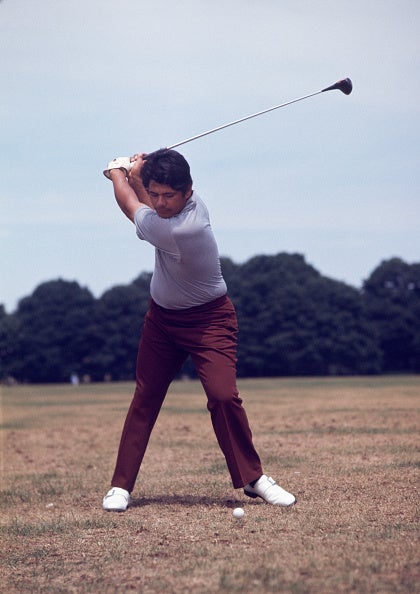マーク・イメルマン――2008年マスターズチャンピオンのトレバー・イメルマンの兄――が,「open-to-closed golf swing」と「closed-to-open」との違いについて書いています。一時期盛り上がった「フェースローテーションする・しない」につながる話だと思いますが,イメルマンは「どっちにしろ一長一短あるけど,いちばん大事なのは,プレッシャーのかかる場面で(自分にとって)再現性の高い方法を選ぶことだからね」と結論づけてます。あと,「開きすぎも良くないし,閉じすぎも良くない」と。
個人的には,「閉じて開く」の代表例としてトレビノが選ばれているのが嬉しいです。

ソース
The difference between an open-to-closed swing, and a closed-to-open by Mark Immelman, 17 July 2020
概要
個人的には,ダウンスイングとインパクトにかけてクラブフェースをピシャっと閉じれて,しかも閉じすぎてフックすることを恐れない,という考えが好きだ。私にとってそれは基本的に,プルショットと左右両方のミスとを減らせる。 *1
しかし最近,著名なインストラクターでその逆を教える人は多いし,主要なプレーヤーも(ダウンスイングで)フェースをシャットからオープンに動かしている。このアプローチには私もある程度賛同する。なぜならこれはROCを減らし,このアプローチにメリットがあるからだ。 *2
最終的には,インパクトゾーンでクラブフェースをスクエアにするには,どっちが自分の役に立ちますか,という話になる。 *3
「オープンフェース」のゴルファー(バックスイングのトップでクラブヘッドのトウが地面の方を指している)は,インパクトにかけてフェースをスクエアにするために,クラブヘッドを「投げつける」必要がある。「クローズドフェース」のプレーヤー(バックスイングのトップでクラブフェースが上空の方を指す)は,同じ結果を実現するためにインパクトエリアでクラブヘッドを「そのままに」にする。 *4
以下は,それぞれの特徴。 *5
Open to Closed
主要例:ベン・ホーガン,ウェブ・シンプソン,フィル・ミケルソン *6
- 切り返しで左手首が掌屈方向に動く *7
- インパクトで左手がプロネーションする *8
- 頭は「後ろ」に置いたままで,目線はボールの後ろに残したまま *9
- 胸と肩のローテーションは少しゆっくりで,インパクトにかけてクラブヘッドはボディの軸回転を「追い越して」加速する The rotation of the chest and shoulders should be a little slower and the clubhead should be accelerating “past” the body pivot through impact; and
- 手首と前腕はインパクト後に「交差」する *10

Closed to Open
主要例:ダスティン・ジョンソン,ブルックス・ケプカ,リー・トレビノ,ビクター・ホブラン *11
- 切り返しで左手首は掌屈方向に動かない *12
- 左手はさほどプロネーションしないし,インパクト後に左手首は「持ち上がる」しクラブヘッドよりも前にありつづける *13
- 頭と目線はインパクトにかけてターゲット方向にローテーションする *14
- ボディの軸回転はよりアグレッシブで,それによってインパクトにかけてクラブを引きつづける *15
- 右肘は左腕の下にありつづけ,インパクト後に前腕の交差は少ない *16

*1:Personally, I like the idea of the ability to be able to slam the clubface shut on the downswing and through impact, without the fear of closing it too much and hooking the ball. To me that essentially reduces the tendency of a pulled shot and a two way miss.
*2:Nowadays though, a number of highly respected instructors will argue otherwise and a number of leading golfers play from shut to open. To a certain extent I agree with this approach as the theory of reducing the rate of clubface closure through impact, and hence this approach has merit.
*3:Ultimately, it all depends on what helps you get that clubface squared through the impact zone.
*4:“Open-faced” golfers (where the toe of the clubhead is dangling more towards the ground at the top of the backswing) need to “sling” the clubhead through impact to square the face. “Closed-faced” players (where the clubface is pointing towards the sky at the top of the backswing) “hold” the clubhead through the impact area to achieve the same result.
*5:Here are some examples of each:
*6:Notable examples: Ben Hogan, Webb Simpson, Phil Mickelson
*7:The lead wrist should be moving into flexion in the transition into the downswing;
*8:The lead hand should be moving into pronation (palm pointing toward the sky) through impact;
*9:The head should remain “back” and the eyeline should remain on the back of the golf ball;
*10:The wrist and forearms should “cross over” each other post impact.
*11:Notable examples: Dustin Johnson, Brooks Koepka, Lee Trevino, Viktor Hovland
*12:The lead wrist should not move toward Flexion in the transition;
*13:The lead hand should not pronate as much and the lead wrist should “raise” and remain ahead of the clubhead until after impact;
*14:The head and eyeline should rotate toward the target through impact;
*15:The body pivot should move more aggressively and lead the club through impact; and
*16:The trail elbow should remain more under the lead arm with less forearm crossover after impact.